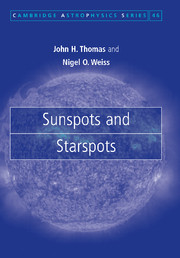Book contents
- Frontmatter
- Contents
- Preface
- 1 The Sun among the stars
- 2 Sunspots and starspots: a historical introduction
- 3 Overall structure of a sunspot
- 4 Fine structure of the umbra
- 5 Fine structure of the penumbra
- 6 Oscillations in sunspots
- 7 Sunspots and active regions
- 8 Magnetic activity in stars
- 9 Starspots
- 10 Solar and stellar activity cycles
- 11 Solar and stellar dynamos
- 12 Solar activity, space weather and climate change
- 13 The way ahead
- Appendix 1 Observing techniques for sunspots
- Appendix 2 Essentials of magnetohydrodynamic theory
- References
- Index
6 - Oscillations in sunspots
Published online by Cambridge University Press: 28 October 2009
- Frontmatter
- Contents
- Preface
- 1 The Sun among the stars
- 2 Sunspots and starspots: a historical introduction
- 3 Overall structure of a sunspot
- 4 Fine structure of the umbra
- 5 Fine structure of the penumbra
- 6 Oscillations in sunspots
- 7 Sunspots and active regions
- 8 Magnetic activity in stars
- 9 Starspots
- 10 Solar and stellar activity cycles
- 11 Solar and stellar dynamos
- 12 Solar activity, space weather and climate change
- 13 The way ahead
- Appendix 1 Observing techniques for sunspots
- Appendix 2 Essentials of magnetohydrodynamic theory
- References
- Index
Summary
Various kinds of wave motions have been observed in sunspots. These include characteristic umbral oscillations with periods around 3 minutes, umbral oscillations with periods around 5 minutes (which differ in several respects from the 5-minute p-mode oscillations in the quiet photosphere), and large-scale propagating waves in the penumbra. These oscillatory phenomena are of considerable interest because they are the most readily observable examples of magnetohydrodynamic waves under astrophysical conditions. In addition, observations of oscillations in a sunspot and its nearby surroundings can be used to probe the structure of a sunspot below the solar surface (‘sunspot seismology’).
Interest in sunspot oscillations began in 1969 with the discovery of periodic umbral flashes in the Ca II H and K lines by Beckers and Tallant (1969). These flashes were soon attributed by Havnes (1970) to the compressive effects of magneto-acoustic waves. In 1972 three other types of sunspot oscillations were discovered: running penumbral waves in Hα (Giovanelli 1972; Zirin and Stein 1972); 3-minute velocity oscillations in the umbral photosphere and chromosphere (closely connected to the umbral flashes: Giovanelli 1972; Bhatnagar and Tanaka 1972); and 5-minute velocity oscillations in the umbral photosphere (Bhatnagar, Livingston and Harvey 1972). For some time these three types of oscillations were considered as distinct phenomena, but recent work suggests that they might actually be different manifestations of the same coherent oscillations of the entire sunspot (Bogdan 2000). Here we shall follow the historical development of the subject by discussing the three types of oscillations separately before attempting to present a unified picture.
- Type
- Chapter
- Information
- Sunspots and Starspots , pp. 106 - 122Publisher: Cambridge University PressPrint publication year: 2008

